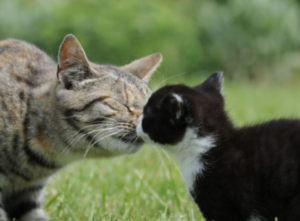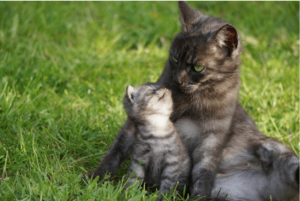
So what is our real relationship with cats and how do they view us?
In nature when looking at cat colonies what we see is that adult cats do not tend to meow to each other. They make all sorts of other vocalizations, but adult to adult they generally don’t meow. They may caterwaul, chiiter, chirp, yowl, hiss and growl. Meowing, however, seems to be a specific vocalization between kittens and their moms.
Dogs recognize that people aren’t dogs and they treat us differently than they treat other dogs. On the other hand cats seem to think of us as cats, bigger ones and maybe a bit clumsy. They engage in what are normally cat to cat behaviors with us, like raising their tails, rubbing against us (kittens do this to mother cats), grooming us, purring and kneading. It’s not that cats don’t see that we aren’t real cats. It’s more like they can’t adjust their behavior “language” with us. They can’t take us out of that box. As I mentioned earlier, adult cats in nature generally don’t meow to each other. But kittens obviously meow to their mothers, and interesting adult cats meow to us. It is for all these reasons that we feel we are in a mostly maternal relationship with cats. We are all the mothers!
 So how does this impact our relationship with cats on a practical level?
So how does this impact our relationship with cats on a practical level?
Frequently I am asked this question, “My cat loves me, but he ignores my boyfriend. What can I do?” My reply is to ask the question to which I already (generally) know the answer. “Who feeds the cat, you or the boyfriend?” Invariably, the answer is it’s the girlfriend who does all or most of the feeding. This makes sense. Mother cats feed. Cats look to the food provider as another reason why they are the mother. And doesn’t it make sense that we’re going to be more affectionate with the person who feeds us filet mignon every day? Cats often rub against us because they want food. Feed me! And this can also be interpreted as affectionate behavior. So the behavior plan is to put the non-favorite person in charge of meal time, along with scheduled special sessions that incorporate high value treats with petting and some play.
Cats have two primary ways in which they ask us for things, food in particular.
Cats who identify more with the kitten-mother relationship ask us for food the way a kitten asks for it, typically meowing, purring, rubbing or crying. But cats who really identify as very confident predators often ask for food in the way they obtain it, e.g. by hunting for it. This results in cats who come after us for food, and get food aggressive, in extreme cases by attacking us, or with somewhat milder expressions of behavior like grabbing food off a plate, or opening cabinet doors.

If your cat is acting out with respect to food, please contact me to schedule an appointment so that I can create a complete and customized behavior modification plan for you..

By Stephen Quandt
Copyright © Stephen Quandt, 2023, All Rights Reserved | Email: [email protected] | Instagram: @CatBehaviorHelp
